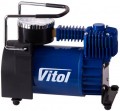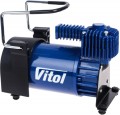Performance
The capacity of the compressor (see "Type") is the maximum amount of air that it can pump into the tyre in a minute.
Higher performance reduces the time required to inflate the wheel; on the other hand, this parameter directly affects the dimensions, weight, power consumption and price of the compressor. So it is worth choosing according to performance, taking into account real needs. So, for a “duty” tyre inflation in a passenger car, a compressor with a low operating speed is quite enough — up to
20 L / min inclusive. And if the speed of full pumping is also important for you (for example, after replacing the rubber) — you can choose a unit for
21 – 40 L / min. In turn, models with more solid characteristics —
41 – 60 L / min and
more — are intended mainly for heavy equipment like SUVs, trucks, tractors, etc.
Separately, it should be noted that this parameter is NOT suitable for calculating the exact inflation time (even if the exact volume of air in the wheel is known). The fact is that the actual performance of the compressor is always lower than the claimed one: the figures in the characteristics are indicated for free air outlet, and when pumping the wheels, the pumping speed will inevitably be lower due to the resistance of the nipple.
Current consumption
The amount of current drawn by the compressor during operation. For most models intended for use with passenger cars, this indicator is at the level of 12-14 A. A small current consumption is preferable from the point of view of energy saving, but the performance of the device largely depends on this indicator (see "Performance").
Power
Rated power consumed by the compressor during operation.
This parameter primarily affects the features of connecting the unit to the on-board network through the cigarette lighter socket. Such a socket has restrictions on load power, and these restrictions are different for different cars; and even in the same car, different connectors — the cigarette lighter itself and a separate socket of the same format — can differ in allowable power. However, most of these connectors can easily cope with units with a power of up to 100 – 120 W; but if you get a more powerful compressor, you should clarify the possibility of using it with a specific cigarette lighter (the easiest way to do this is according to the documentation for the car). If the device is planned to be powered through "crocodiles" or from a 230 V socket (see "Connection"), you can not pay much attention to the power consumption.
Also, more powerful compressors, usually, have a greater capacity and/or maximum pressure, but there is no strict relationship here.
Connection
Ways of connection to the power supply provided in the design of the compressor (see "Type").
—
Cigarette lighter. Connection to a standard cigarette lighter socket (or a separate auto socket of the same format). This method is convenient because the compressor does not need to open the hood. On the other hand, cigarette lighters have limits on maximum power, and in different cars (and even in different sockets of the same car), these limits can vary markedly. See Power Consumption for details.
—
Crocodiles. Connect directly to the battery terminals using crocodile clips. This method is somewhat more complicated than working from the cigarette lighter — you need to open the hood and pull the wires to the battery. On the other hand, it allows you to use the power of the on-board network to the fullest without worrying about overloads and the integrity of the fuses, making it suitable for even the most powerful and performant compressors. In addition, the “crocodiles” device can be connected not only to the on-board network, but also to a separate battery; in some cases, this possibility is useful (for example, if the car’s own battery is already running low, but there is a “fresh” battery nearby).
—
Cigarette lighter / "crocodiles". The ability to use any of the connection options described above is optional. This provides convenience and al
...lows you to choose the optimal format of work depending on the situation. For example, for quick pumping of one or two wheels, you can use the cigarette lighter, but for long-term work, food through the “crocodiles” is better suited.
— Fork. Plug for connecting to a regular 230 V socket (see "Power"). It is used in compressors having only this type of supply.
— Cigarette lighter / plug. Available on both 12V and 230 V models; for the first, a cigarette lighter is used, for the second, a plug.
— Cable (to the battery). Connection directly to the battery using cables with flat terminals, which are clamped into the battery terminals when connected. This design provides a tighter contact than the "crocodiles" described above, but is less convenient when connecting and disconnecting the compressor.Hose length
The length of the hose through which air is pumped into the tyre. The larger it is, the more convenient the device is to use. But it is rare that the compressor is left far from the wheel, especially if a pressure gauge is placed on the device, which must be periodically checked. For domestic use in cars, a one and a half metre long hose is enough. Powerful and performant models can be equipped with a hose of 7 metres or more, but these are more solutions for commercial use in car services.
Autostop function
Function that
automatically stops operation when a sufficient level of tyre pressure is reached. Usually, the pressure at which the auto-stop is triggered can be set at the discretion of the user.
This function greatly simplifies the work with the pump: the risk of overfilling the tyre is reduced to almost zero, while the user does not need to monitor the pumping process, because the pump will stop at the right time. On the other hand, hitchhiking significantly affects the price. It is found only in electric compressors (see "Type").

